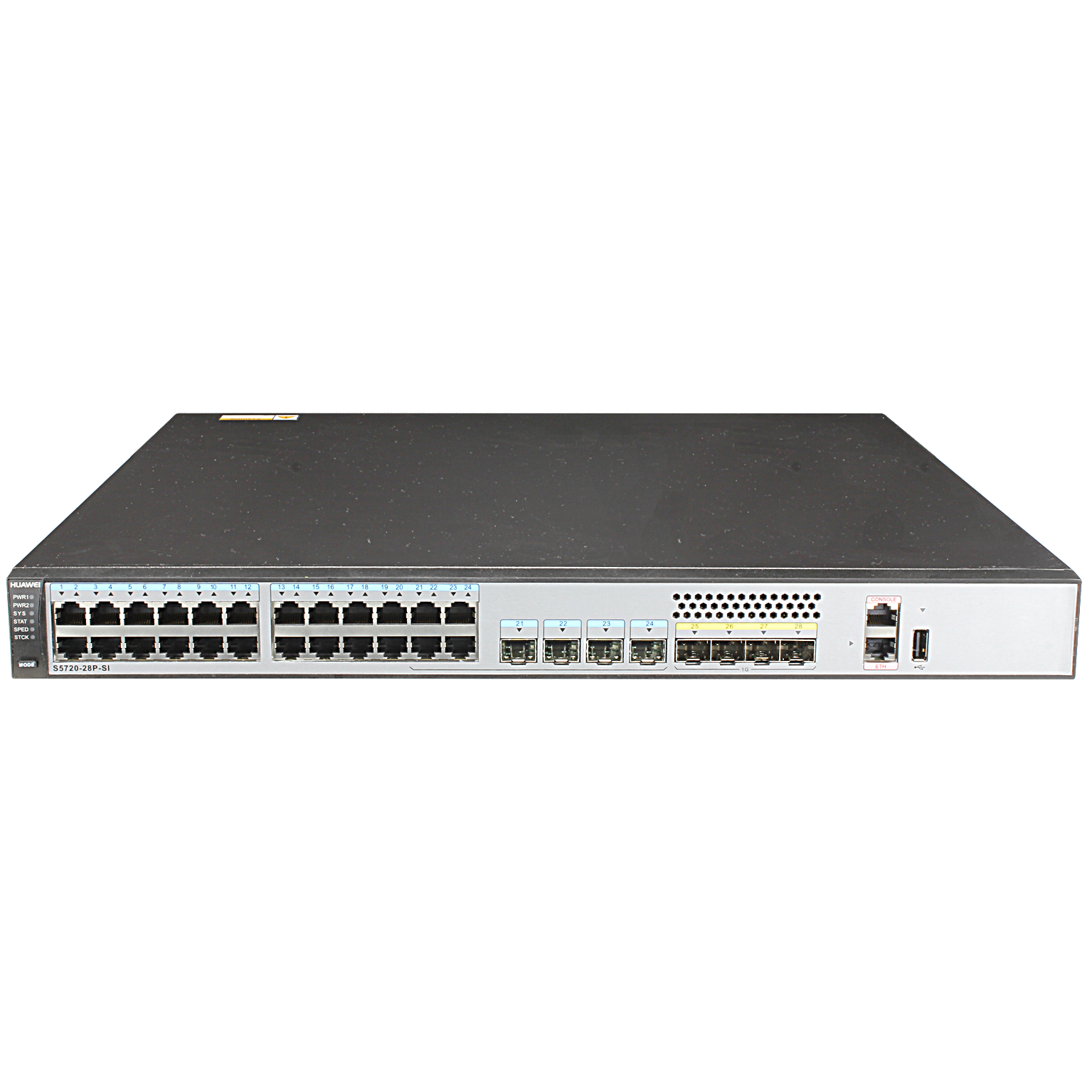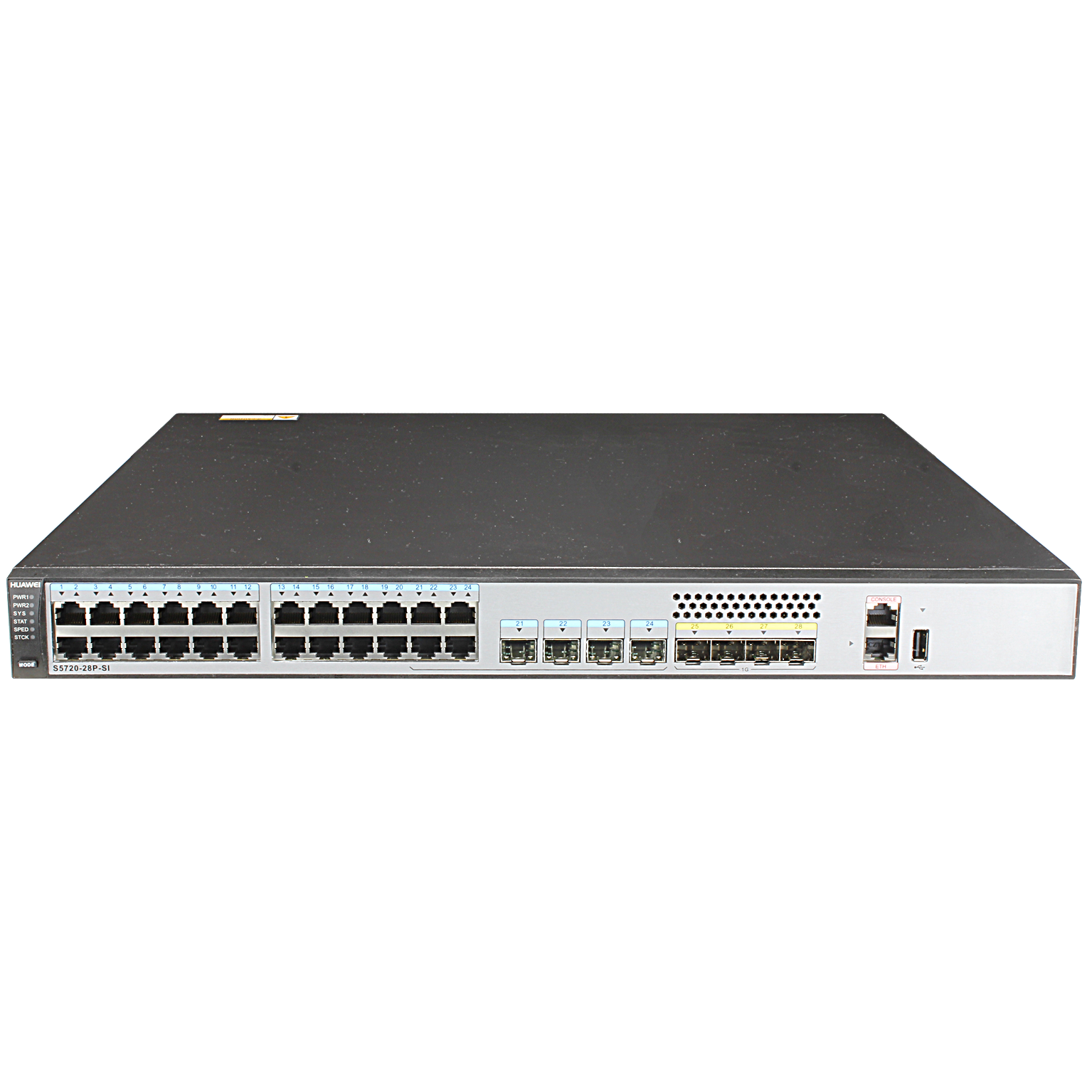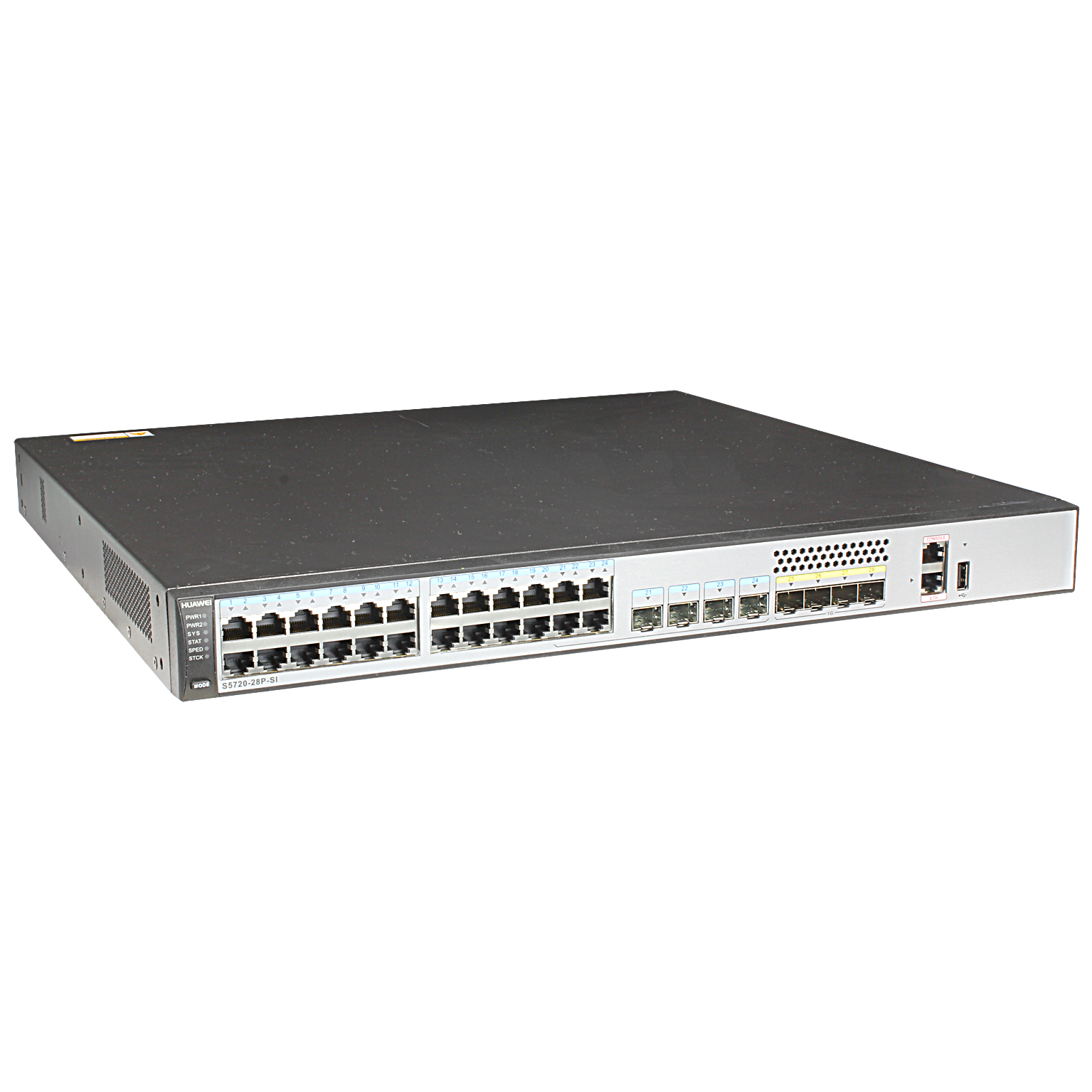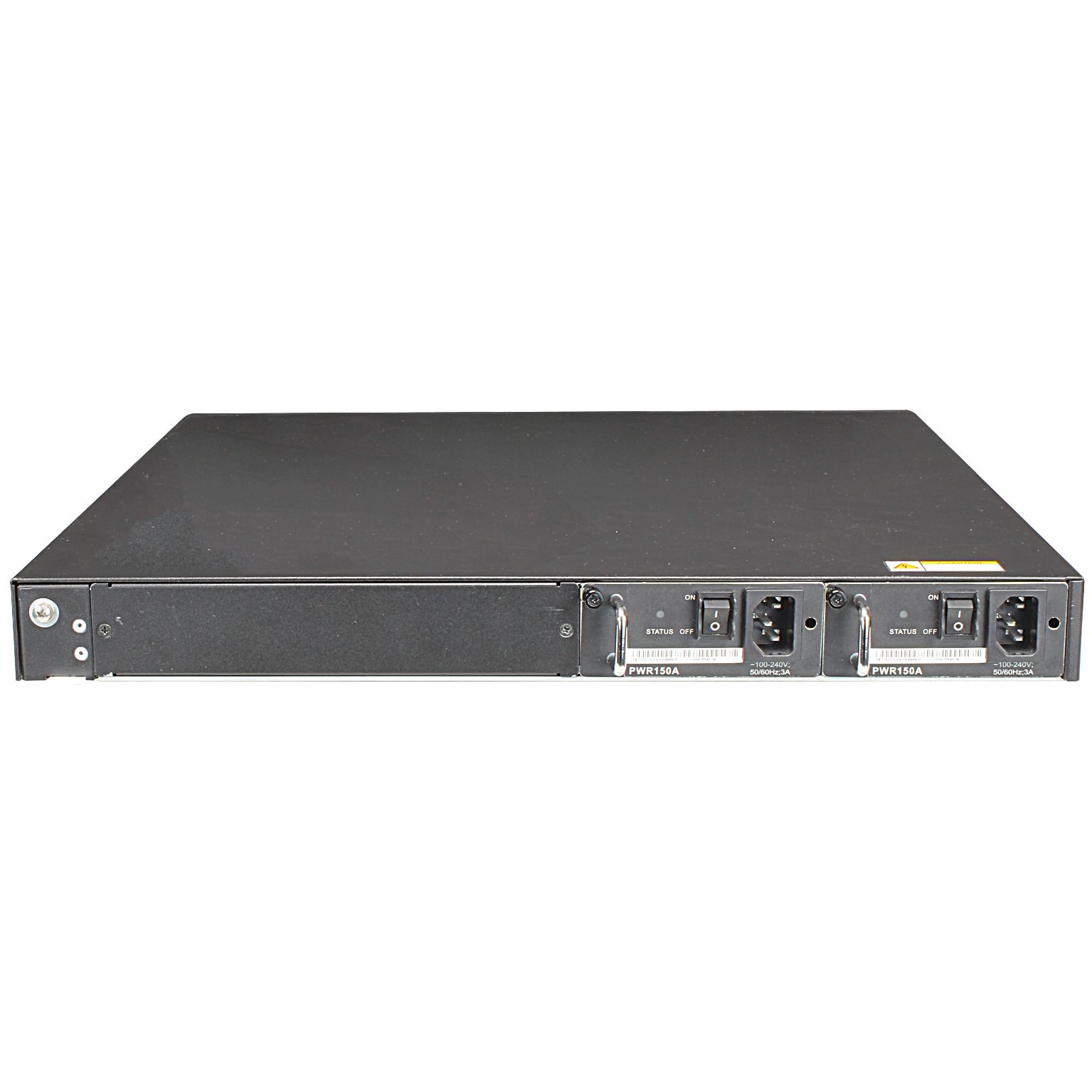- |
- opticomms@opticomms.com
- |
- +86-0755 2100 4659


Huawei S5720-28P-SI-AC switch with 24-ports 1000BASE-T, 4-ports GE SFP combo, 4-ports GE SFP
With 2 power slots, 1 AC power module
No extension slot
Forwarding perfomance: 42Mpps
Switching capacity: 336Gbps
16K MAC address entries
Non-POE
The S5720-SI series switches (S5720-SI for short) are next-generation standard gigabit Layer 3 Ethernet switches. Large switching capacity, high-density GE interfaces, and 10GE uplink interfaces and Pv6 forwarding capabilities. S5720-SI can be applicable to campus networks and data centers. S5720-SI integrates many advanced technologies in terms of reliability, security, and energy saving. Simple and convenient for installation and maintenance to reduce customers' O&M costs and help enterprise customers build a next-generation IT network.
| Item | Description |
| Fixed port |
24 Ethernet 10/100/1000 ports, 4 of which are dual-purpose 10/100/1000 or SFP P series: 4 Gig SFP X series: 4 10 Gig SFP+ |
| Forwarding performance | 42 Mpps |
| Extended slot | NA |
|
MAC address table |
IEEE 802.1d |
| 16K MAC address entries | |
| MAC address learning and aging | |
| Static, dynamic, and blackhole MAC address entries | |
| Packet filtering based on source MAC addresses | |
| VLAN | 4K VLANs |
| Guest VLAN and voice VLAN | |
| GVRP | |
| MUX VLAN | |
| VLAN assignment based on MAC addresses, protocols, IP subnets, policies, and ports | |
| 1:1 and N:1 VLAN Mapping | |
|
Wireless AC |
AP access control, AP domain management, and AP configuration template management Radio management, unified static configuration, and dynamic centralized management WLAN basic services, QoS, security, and user management CAPWAP, Tag/terminal location, and spectrum analysis |
| Jumbo frame | 10K |
| IP routing |
Static routes, RIP v1/2, RIPng, OSPF, OSPFv3, IS-IS, IS-ISv6, BGP, BGP4+, ECMP, routing policy |
| IPv6 features | Neighbor Discovery (ND) |
| Path maximum transmission unit (PMTU) | |
| IPv6 Ping, IPv6 Tracert, and IPv6 Telnet | |
| 6 to4 tunnel, ISATAP tunnel, and manually configured tunnel | |
|
ACLs based on source IPv6 addresses, destination IPv6 addresses, Layer 4 ports or protocol types |
|
| Multicast Listener Discovery (MLD) v1/v2 snooping | |
| Multicast forwarding | IGMP v1/v2/v3 snooping and IGMP fast leave |
| Multicast forwarding in a VLAN and multicast replication between VLANs | |
| Multicast load balancing among member ports of a trunk | |
| Controllable multicast | |
| Port-based multicast traffic statistics collection | |
| IGMPv1/v2/v3, Protocol Independent Multicast Sparse Mode (PIM-SM), and Protocol Independent | |
| Multicast Dense Mode (PIM-DM), and Protocol Independent Multicast Source-Specific Multicast (PIM-SSM) | |
| Multicast Source Discovery Protocol (MSDP) | |
| QoS/ACL | Rate limitation in the inbound and outbound directions of a port |
| Packet redirection | |
| Broadcast storm control | |
| Port-based traffic policing and two-rate and three-color CAR | |
| Eight queues per port,Weighted round robin (WRR), deficit round robin (DRR), strict priority (SP), WRR+SP, and DRR+SP queue scheduling algorithms | |
| Weighted random early detection (WRED) | |
| Re-marking of the 802.1p priority and DSCP fields of packets | |
|
Packet filtering on Layer 2 to Layer 4, filtering out invalid fr ames based on the source MAC address, destination MAC address, source IP address, destination IP address, TCP/UDP source/destination port number, protocol number, or VLAN |
|
| Queue-based rate limitation and shaping on ports | |
| HQoS | |
| Security features | Hierarchical user management and password protection |
| DoS attack defense, ARP attack defense, and ICMP attack defense | |
| Binding of the IP address, MAC address, interface number, and VLAN ID of a user | |
| Port isolation, port security, and sticky MAC | |
| MAC Forced Forwarding (MFF) | |
| Blackhole MAC address entries | |
| Limit on the number of learned MAC addresses | |
| IEEE 802.1x authentication and the limit on the number of users on an interface | |
|
AAA authentication, RADIUS authentication, HWTACACS+ authentication, and NAC SSH v2.0 |
|
| Hypertext Transfer Protocol Secure (HTTPS) | |
| CPU defense; Blacklist and whitelist; MACSec ready | |
| Reliability | RRPP ring topology and RRPP multi-instance |
|
Smart Link tree topology and Smart Link multi-instance, providing the millisecond-level protection switchover |
|
| SEP | |
| G.8032 Ethernet Ring Protection Switching (ERPS) | |
| STP (IEEE 802.1d), RSTP (IEEE 802.1w), and MSTP (IEEE 802.1s) | |
| BPDU protection, root protection, and loop protection | |
| Super Virtual Fabric (SVF) |
Working as the parent node to vertically virtualize downlink switches and APs as one device for management |
| Supports a two-layer client architecture | |
|
Management and Maintenance |
Virtual cable test, SNMP v1/v2c/v3, RMON |
| Network management system (NMS) and Web management | |
| System logs and multi-level alarms | |
| 802.3az EEE | |
| GVRP | |
| Dying Gasp upon power-off | |
| Interoperability | VLAN-Based Spanning Tree (VBST), working with PVST, PVST+, and RPVST |
| Link-type Negotiation Protocol (LNP), similar with DTP | |
| VLAN Central Management Protocol (VCMP), similar with VTP | |
| Operating environment |
Operating temperature: 0-1800 m altitude: 0-45℃ 1800-5000m altitude: The operating temperature reduces by 1℃ every time the altitude increases by 220m. Relative humidity: 5% to 95% (noncondensing) |
| Input voltage |
AC: Rated voltage range: 100 V to 240 V AC, 50/60 Hz Maximum voltage range: 90 V to 264 V AC, 50/60 Hz DC:Rated voltage range: –48 V to –60 V, DC Maximum voltage range: –36 V to –72 V, DC |
| Dimensions (mm) | 442 (W) x 420 (D)x 43.6 (H) |
| Typical power consumption |
21.2W |
ShenZhen OPTICOMM Technology CO.,LTD
Tel: +86-0755 2100 4659
Fax: +86-0755 2100 4659
Mail: opticomms@opticomms.com



